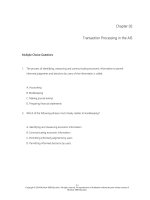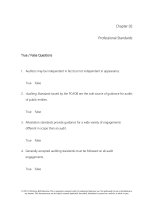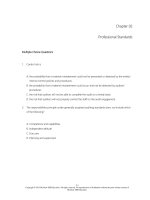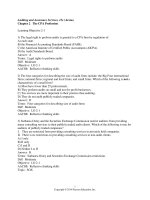Race and ethnic relations american and global perspectives 9th edition marger test bank
Bạn đang xem bản rút gọn của tài liệu. Xem và tải ngay bản đầy đủ của tài liệu tại đây (446.08 KB, 14 trang )
CHAPTER 2
ETHNIC STRATIFICATION: MAJORITY AND MINORITY
WHAT’S NEW TO THE 9TH EDITION?
Additional explanation of different types of sociological minorities, including gender
and age.
Updated statistical data on all groups.
Updated citations and literature.
Bulleted summary section.
Critical thinking questions at the end of the chapter.
Updated key concepts.
Updated and enhanced tables and figures.
CHAPTER OUTLINE
Stratification Systems
Power and Stratification
Stratification and Ideology
Ethnic Stratification Systems
Minority Groups
Differential Treatment
Social Definition
Differential Power
Categorical Treatment
Sociological and Numerical Meaning
Types of Minorities
Dominant Groups
Political and Economic, Dominance
Cultural Power
Control of Immigration
Relative Dominance
Middleman Minorities
The Relativity of Dominant and Minority Status
Ethnic Strata: Clarity and Mobility
Mobility between Strata
Caste
Class, Ethnicity and Power
The Relationship of Ethnicity to Social Class and Power
Class
Societal Power
Ethnicity, Class, and Power Reconsidered
Individual Achievement
Underrepresentation
Privileges and Handicaps
Changing Class Positions
The Origins of Ethnic Stratification
Forms of Contact
Conquest
Annexation
Voluntary Immigration
Involuntary Immigration
Outcomes of Contact
Lieberson’s Model
Noel’s Model
Minority Responses to Subordination
Pluralistic Minorities
Assimilationist Minorities
Secessionist Minorities
Militant Minorities
Summary
Critical Thinking
KEY TERMS, CONCEPTS, AND NAMES
assimilationist minority p. 46
caste system p. 37
charter group p. 33
dominant ethnic group p. 33
Donald Noel p. 44
ethnic hierarchy p. 45
ethnic minority p. 39
ethnic stratification p. 39
ideology p. 40
indigenous superordination p. 44
involuntary immigration p. 43
middleman minority p. 34
migrant superordination p. 44
militant minority p. 47
minority group p. 47
pluralistic minority p. 46
secessionist minority p. 47
social mobility p. 34
social stratification p. 47
socioeconomic status p. 36
Stanley Lieberson p. 44
voluntary immigration p. 43
LECTURE IDEAS
1) The Poverty Game: Put students in groups of three and assign each a lump sum
monthly income. Make sure that 8 of 10 groups live in poverty (monthly incomes
$450.00 or less) and 2 of 10 groups live in opulence (monthly incomes $7,000.00 or
more). Tell all groups to keep their income levels private until they report their
budget at the end of the exercise. Have group members budget as though they were
in a single-parent with two children family for three consecutive months (that
means that each group gets their monthly income three times, once per month)
using the following budget categories: food, transportation, housing (including
utilities), medical, and miscellaneous. Give the following guidelines: any welfare that
is available can be used to make up for income shortfalls; no debt can be incurred;
no family can be sources of further income; and no more income can be obtained for
the three months. Have students with lower incomes present first and have each
group write their budgeting strategies on the board as they present to the entire
class. The point is to let most of the students struggle with a small measure of the
challenges faced by indigent persons (even if for only one hour). And to allow the
majority of students to experience relative poverty when they discover that there
were very rich groups in the room.
2) What’s In Your Wallet?: Ask students to empty the contents of their wallets, pockets,
and/or purses onto the desk (not their money or personal hygiene products). Assign
them to economic classes using the following arbitrarily selected criteria (you can
readily modify these criteria as needed): students who have nothing on their desks
are the richest class; students with keys are upper middle class; students with bills,
tickets, or receipts are the working middle class; students with credit cards are the
working poor class; students with any facial care products are assigned minority
status and are considered twice as likely to be looked over for opportunities. Now
have them write a life course plan as though they had to follow the plan from their
current economic and minority status. These are the life course stages for them to
plan: education/vocational training; vocation/profession employment; housing
purchase; promotion possibilities; and retirement plan. The point is that many in
society don’t have equal access to social and economic rewards. How is the process
of assignment based on what a student had in their wallet similar or different to the
processes of assignment based on race, class, gender, lifestyle, etc?
3) Hegemony and Ideology: Draw from Gramsci’s discussion of hegemony to explain
the importance of ideologies for maintaining inequality. Focus specifically on the
ideology of equal opportunity in the U.S. and explore the extent to which this is a
reality.
4) Social Mobility and Racial Inequality: Use current studies to describe the levels of
inequality in the U.S. Black families earn less and have less wealth than White
families. In addition, middle-class blacks are much less likely than middle-class
whites to attain or surpass the class status of their parents. Provide concrete data
on stratification to supplement the author’s discussion of this.
QUESTIONS FOR DISCUSSION
1) Explain the difference in ascribed and achieved characteristics. Discuss the
challenges faced by various groups who cannot change ascribed traits that work
against them when competing for social and economic rewards.
2) Discuss the African American experience in terms of: involuntary migration, past
and current trends in stratification, and social mobility (or the lack thereof). How is
this minority group unique in comparison to others?
3) Describe the experience of annexation of Mexican-Americans. How has this group
responded in terms of: pluralistic, assimilation, secession, and military minority
responses?
4) Explain Noel’s power differential, competition, and ethnocentrism concepts. How do
these fit today’s minority group struggles?
5) Why did South Africa have a majority of its population that did not belong to the
dominant group?
6) Discuss the contrast the author draws between the Virginia Tech shooting and the
Oklahoma City bombing. Ask the students how the media and authorities might have
responded had Timothy McVeigh been an Arab. Ask the students how the media
and authorities might have responded had the perpetrators of 9/11 been white
Americans.
7) In today’s political climate, there is a lot of anti-immigrant sentiment. To what
extent is that related to perceived cultural and racial differences between the
majority population and the immigrant populations?
INTERNET ACTIVITIES
1) Go to />Either register or take a free preview. What types of services are offered on this
website and who is most likely to benefit from using them? List three things you
learned from the news, education, and social links. What is the main purpose of
this website?
2) Go to />Register (for free) and browse the site. What is the main focus of this website?
List three things you learned about the Japanese language and/or culture. What
can non-Japanese-Americans gain from this website?
3) Go to />
What is the main focus of this site? What can non-Filipino-Americans gain from
this website? List three things you learned about the Filipino-American
experience.
4) Go to />Read some of the articles that discuss anti-Arab sentiment around the world.
How does this play out differently in different contexts? Directly compare one
incident in the U.S. to one in another country to make your case.
5) Go to />Skim the description of the Indian caste system. How does this differ from the
racial hierarchy in the U.S.? In what ways is it similar?
INFOTRAC ACTIVITIES
Access Chenoa Flippen’s article called “Unequal Returns to Housing Investments? A study
of Real Housing Appreciation among Black, White, and Hispanic Households.” Social
Forces, June 2004 v82 i4 p1523. Consider the fact that a home purchase represents the
single most significant financial investment of the average American family. Buying a home,
paying it off, and having it as an economic resource for later life impacts access to economic
rewards at almost every level. Flippen discusses ethnic stratification as it relates to
residential value, especially home appreciation over time. What were the findings
pertaining to ethnic home appreciation? How does it impact overall wealth holdings of
mature ethnic minorities? Which factors contribute to better or worse appreciation? How
many of these factors can be influenced by ethnic minorities? Why does the author
emphasize integration over segregation?
STUDENT ACTIVITIES
1) List the education level and class standing of your parents, and all of your
grandparents. Estimate your own education level and class standing once you are
established in your chosen career. Will you experience intergenerational mobility?
Does race, class, gender, lifestyle, or disability impact your findings? Did race, class,
gender, lifestyle, or disability impact your parents’ and grandparents’ educational
and class experience?
2) Form groups of three and come up with a multi-faceted categorization of a person
who has at least five ethnic-minority or other stratification factors that would land
them in the best and in the worst social standing for competing for social and
economic rewards.
3) Interview two undergraduate students, one who is in the dominant group and
another who is in an ethnic minority group. Question these undergraduates on how
their own race, class, gender, disability, or lifestyles will positively or negatively
impact their educational and career pursuits. You will report your findings in class
and summarize them onto one page, broken down by race, class, gender, disability,
and lifestyle which were reported along with advantage or disadvantage. How do
these findings reflect the larger social findings?
4) List foods that might be found in the “ethnic foods” aisle of the supermarket versus
foods in other aisles. What does that tell us about which ethnic groups are more
assimilated into U.S. society?
5) Name a group that has completely assimilated into U.S. society and a group that has
chosen the pluralistic route. Take stock of the assimilationist versus pluralistic
routes in terms of the advantages of each one. Also, discuss what factors facilitate
pluralism versus assimilation.
ADDITIONAL RESOURCES FOR THE INSTRUCTOR
Max Weber’s discussion of life chances opens an entirely unique world view of
opportunities that can be influenced by the individual and opportunities that individuals
lack by virtue of some ascribed characteristic. Using his original text (The Protestant Ethic
and the Spirit of Capitalism) or a paraphrased version found in any introduction to
sociology text, have students consider how the intersection of race, class, gender,
disabilities, and lifestyles impacts disadvantaged persons who attempt to procure goods,
obtain life position, and/or obtain inner satisfaction as they compete for economic and
social rewards.
SUGGESTED READINGS
Jackman, Mary R. 1994. The Velvet Glove: Paternalism and Conflict in Gender, Class, and Race
Relations. Berkeley: University of California Press. Analyzes how dominant groups use
persuasion, in the form of ideology, rather than force to create legitimacy and to sustain
systems of social inequality.
Steinberg, Stephen. 1989. The Ethnic Myth: Race, Ethnicity and Class in America. Updated
and expanded ed. New York: Atheneum. Deals with the issue of ethnic versus class
factors in group mobility, leaning strongly toward the latter.
Wilson, William J. 1973. Power, Racism, and Privilege: Race Relations in Theoretical and
Sociohistorical Perspectives. New York: Free Press. Using a power-conflict approach,
explains the development of racial stratification, illustrated with a comparison of the
United States and South Africa.
MULTIPLE CHOICE QUESTIONS
1. Stratification is legitimized by an ideology
a. that justifies the unequal distribution of rewards.
b. that most people accept without dispute.
c. in order to avoid a discussion of genetic factors.
d. that determines how many strata a society will have.
W2. All of the following contribute to stratification, except
a. unequal distribution of resources.
b. ideologies.
c. social institutions.
d. random chance.
3. _______________techniques are commonly used only in societies where the prevailing
system is not accepted by a significant part of the________________.
a. Coercive; government
b. Coercive; populace
c. Ideological; rich
d. Ideological; populace
4. Most stratification systems
a. favor the masses.
b. exclude racism in any form.
c. require the development of an effective ideology.
d. treat most groups equally.
5. In ethnic stratification, those most like the dominant group are more
a. subordinate.
b. exploited.
c. highly ranked.
d. nominally ranked.
W6. Louis Wirth defined a minority group as those who
a. are the same in every way except in the portion of members in public office.
b. people who are treated differently on the basis of their cultural or physical
characteristics.
c. look and act like the dominant group, but have some taint in their history.
d. receive equal economic, but not sociocultural rewards.
7. In a society with a high degree of stratification, we can be sure that
a. the dominant group has the most resources.
b. there will be conflict between minorities.
c. there will be little conflict between minorities.
d. there is a fair distribution of resources.
W8. In the U.S., the ideology of equal opportunity
a. serves to justify social inequality.
b. ensures that Italians get more resources than Greeks.
c. is absolutely untrue.
d. no longer has significance in this society.
9. The dominant group has the power to sustain ideologies because
a. of its power to influence the process of socialization.
b. it is the largest group in society.
c. it controls the media.
d. resistance is rare.
W10. Minority groups can be characterized which characteristic?
a. a group that has a small share of society’s rewards
b. the numerically smallest group in society
c. people can move in and out of this classification
d. a group that is endogamous
11. The dominant ethnic group is the group with all of the following characteristics, except
a. top of ethnic hiearchy.
b. maximal access to recoures.
c. power advantage.
d. historical supremacy.
12. Schermerhorn argued that the ____________group has its language, traditions, customs,
and ideology as the _____________for society.
a. minority; norm
b. dominant; exception
c. dominant; norm
d. minority; role model
13. Porter called the host group the
a. charter group.
b. minority guest group.
c. ethnic outcast group.
d. norm buster group.
W14. When ethnic groups occupy a middle status between dominant and subordinate
groups, it’s called
a. ethnic liasons.
b. political scapegoates.
c. deviant go-betweens.
d. middleman minorities.
15. In the United States, Anglo-Saxons are privileged because they
a. are the dominant group.
b. arrived first.
c. have worked the hardest.
d. are the largest voting bloc.
16. In the U.S., social mobility is limited because
a. people inherit their class positions.
b. most people are not willing to move far from their families.
c. the price of housing is comparatively high.
d. there are no opportunities for advancement.
17. Caste systems are distinct from other systems of ethnic stratification in that
a. movement from one caste to another is highly restricted by custom or law.
b. physical appearance is not important in caste systems.
c. castes are usually culturally similar to one another.
d. caste systems are only found in Asia.
18. Mexican Americans living in what is now the United States’ South West region ___________
after the Mexican-American War.
a. voluntarily migrated
b. were excluded
c. were conquered
d. were annexed
19. Which group involuntarily migrated to the United States?
a. Native Americans
b. Asians
c. French
d. Africans
20. Ethnicity is linked to class status insofar as
a. the members of the dominant ethnic group are most likely to have the greatest
wealth.
b. Education influences which ethnic group you belong to.
c. People in higher classes have more cultural capital.
d. Your class status is wholly determined by your ethnicity.
21. The author compares the Virginia Tech shooting to the Oklahoma City bombing to make
the point that
a. ethnic minorities are more likely than the dominant group to suffer the
consequences of the actions of their co-ethnics.
b. the Tech shooting received much more media coverage.
c. the Oklahoma City bombing received much more media coverage.
d. college students rarely display violent behavior.
22. Pluralistic minorities do not assimilate primarily because
a. they choose not to.
b. their opportunities to do so are limited.
c. their lack of education makes it difficult.
d. their primary goal is to become the dominant group in society.
23. The ethnic factor is unlikely to inhibit Anglo-Americans’ success
a. because they are privileged in every way.
b. because they are all members of the upper class.
c. because they have no ethnic attributes.
d. because they are the dominant ethnic group.
24. Sociologists refer to upward or downward movement between socioeconomic strata as
a. strata travel.
b. social mobility.
c. impoverishment relativity.
d. social enrichment.
25. In general, where groups remain culturally or physically distinct, mobility between
ethnic strata is
a. enhanced.
b. limited.
c. neutral.
d. destroyed.
26. The most rigidly static type of ethnic stratification is called
a. class.
b. pluralism.
c. caste.
d. majority-minority.
27. The Burakumin are considered to be descendants of a less human race in
a. Iran.
b. Japan.
c. South Africa.
d. Brazil.
28. Members of an ethnic group enter a society in large numbers for the first time; their
objective is to become part of the mainstream as quickly as possible. This is an example
of a(n) __________minority.
a. militant
b. secessionist
c. assimilationist
d. archaic
29. The effect of ethnicity is that minority ethnic group members face barriers to rewards
that
a. dominant group members deny.
b. dominant group members do not face.
c. minority group members deny.
d. minority group members bring upon themselves.
30. Sometimes ethnic minority group members are exceptional in their social standing. All
of the following are provided as explanations for this, except
a. there’s not a perfect link between class and ethnicity.
b. exceptions do not represent all minorities in a group.
c. dominant group members often retain privileges not given to exceptional minority
group members.
d. the link between class and ethnicity rarely changes.
Essay and Discussion Questions
1. Briefly describe social stratification, specifying the influence of power on stratification
systems.
2. Explain the relationship between stratification and ideology and the role of ideology in
sustaining social inequality.
3. Explain how ethnic stratification systems differ from other types of stratification
systems.
4. Define minority group and explain the specific features of such groups. Provide
examples of several types of minorities, in addition to ethnic.
5. How might people with disabilities, women, and homsexuals be considered minorities
in the same way as racial and ethnic groups by sociologists? Explain.
6. Define dominant group and explain the basis of dominant group power in multiethnic
societies.
7. Describe middleman minorities and how they differ from both dominant and
subordinate groups in a multiethnic society. What factors make them unique from
dominant and minority groups?
8. Describe the origins of ethnic stratification.
9. Make the claim that either Lieberson’s or Noel’s model best fits the understanding of
outcomes of contacts. Compare and contrast the two models in your answer.
10. Differentiate pluralistic, assimilationist, secessionist, and militant minorities, and
illustrate each.
11. Is white a racial identity? Why or why not?
12. If the U.S. is highly stratified on the basis of race, how can we explain the success of
people like Oprah Winfrey and Condoleeza Rice?
13. Describe one way that your class status might affect your life. Describe one way that
your ethnic status might affect your life. On the basis of these two examples, are there
any parallels between class and ethnicity? Why or why not?
14. The author argues that some inequalities between humans are based on social learning,
while others are based on genetic inheritance. Why is it important for sociologists to
make that distinction?
15. As an example of a pervasive ideology that justifies inequality, the author provides the
example of the ideology of equal opportunity. What is another example of an ideology
that justifies inequality? How are we socialized to accept that ideology?
Answer Key
Multiple Choice Questions
1.
Ans: a
2.
Ans: d
3.
Ans: b
4.
Ans: c
5.
Ans: c
6.
Ans: b
7.
Ans: a
8.
Ans: a
9.
Ans: a
10. Ans: a
11. Ans: d
12. Ans: c
13. Ans: a
14. Ans: d
15. Ans: a
16. Ans: a
17. Ans: a
18. Ans: d
19. Ans: d
20. Ans: a
21. Ans: a
22. Ans: a
23. Ans: d
24. Ans: b
25. Ans: b
26. Ans: c
27. Ans: b
28. Ans: c
29. Ans: b
30. Ans: d
Essay Questions
1. pg. 29-30
2. pg. 29-30
3. pg. 28-32
4. pg. 30-33
5. pg. 30-33
6. pg. 33-35
7. pg. 35-36
8. pg. 43-44
9. pg. 45
10. pg. 46-48
Pick-up
Pick-up
Pick-up
Pick-up
Pick-up
Pick-up
Pick-up
Pick-up
Pick-up
Modified
Pick-up
Pick-up
Pick-up
Pick-up
Pick-up
Pick-up
Pick-up
Pick-up
Pick-up
Pick-up
Modified
Modified
Pick-up
Modified
Modified
Modified
Modified
Pick-up
Pick-up
Modified
Applied
Factual
Factual
Factual
Factual
Factual
Applied
Applied
Conceptual
Factual
Factual
Factual
Factual
Factual
Applied
Factual
Factual
Factual
Factual
Applied
Conceptual
Factual
Applied
Factual
Factual
Factual
Factual
Factual
Factual
Factual
pg. 27-29
pg. 27-29
pg. 28
pg. 28
pg. 29
pg. 29
pg. 29
pg. 39-41
pg. 29-30
pg. 28
pg. 33
pg. 33
pg. 33
pg. 34
pg. 32-34
pg. 36
pg. 37
pg. 43
pg. 44
pg. 46-49
pg. 42-43
pg. 46
pg. 33-37
pg. 37
pg. 37-38
pg. 38
pg. 38
pg. 46
pg. 39
pg. 39-41
11. pg. 37
12. pg. 41-43
13. pg. 41-43
14. pg. 28-30
15. pg. 41









